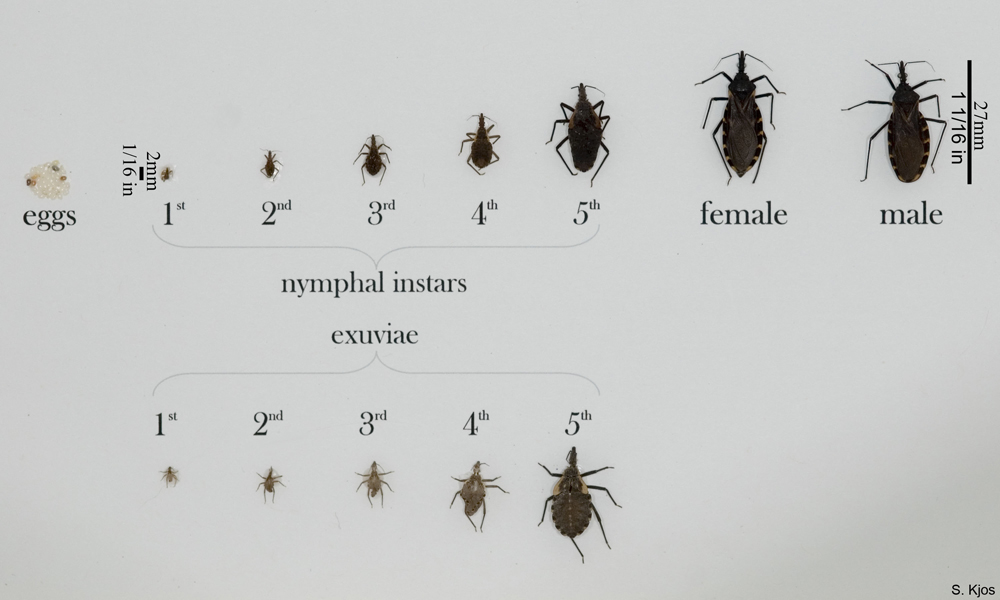The triatomine bug gets its nickname as the ‘kissing bug’ for how it bites, usually around the lips and face of sleeping people.

“These are nocturnal, blood-sucking insects that feed on animals and people’s faces at night, while we’re sleeping,” says Simon Fraser University biology professor Carl Lowenberger.
The bite is not deadly, it’s what the bug leaves behind — feces — that can be a major health concern. If the bugs are infected with the parasite Trypanosoma cruzi, and its fecal matter infect the bite, that can lead to a potentially deadly infection called Chagas disease.
READ MORE: SFU scientists study kissing bugs in effort to curb impact on humans
“While it’s sucking your blood it defecates. In that feces is the parasite,” said Dr. Anil Mangla, assistant director for the San Antonio Metropolitan Health District told CBS.
The Centers for Disease Control and Prevention (CDC) says in the United States the ‘kissing bug’ has now been spotted in 28 states, and there are more than 300,000 people infected with Chagas. Eleven different species of triatomine bugs have been found in the southern U.S.
Triatomine Bug Occurrence by U.S. State (CDC):
- This H3N2 flu strain is spreading ‘rapidly.’ Why subclade K is hitting hard
- U.S. may soon reclassify marijuana to allow medical research. What to know
- EU proposal would ease cross-border abortion access for women facing bans
- Ontario influenza ICU admissions up 127% in past week, hospital association warns

In Canada, estimates range from 5,000-10,000 infected people, most of whom are immigrants from Mexico, Central America and South America, according to Simon Fraser University.

Get weekly health news
Doctors describe it as a silent killer. A person could be infected for years and not know until more serious symptoms set in.
According to researchers at Texas A & M and the CDC, Chagas disease manifests in two phases: acute phase and chronic phase. The acute phase can last for a few weeks or months. Those infected can be symptom-free or could experience fever, fatigue, body aches, headache, rash, loss of appetite, diarrhea, and vomiting.
Of those who are infected with the parasite, close to 30 per cent can suffer from chronic Chagas disease, which can result in cardiac complications such as enlarged heart, heart failure, altered heart rate, and cardiac arrest. Intestinal signs include an enlarged esophagus or colon, which can cause difficulties with digestion.
WATCH: A bug with a deadly bite is in Texas. Doctors say the kissing bug is a silent killer.
READ MORE: ‘Kissing bug disease’: What Canadians need to know about Chagas
What is my risk?
According to the Canadian government, the risk for most travellers is low, however it is higher for travellers visiting countries where Chagas disease occurs and who are:
- visiting or living in rural areas
- sleeping in poorly-constructed housing (for example, housing with cracked walls, mud walls, or thatched roofs)
- sleeping outdoors
Chagas disease facts from the World Health Organization:
- About 6 million to 7 million people are estimated to be infected worldwide, mostly in Latin America.
- Vector-borne transmission occurs in the Americas. The insect vector is a triatomine bug that carries the parasite Trypanosoma cruzi which causes the disease.
- Chagas disease was once entirely confined to the Region of the Americas – principally Latin America – but it has now spread to other continents.
- The disease is curable if treatment is initiated soon after infection.
- In the chronic phase antiparasitic treatment can also prevent or curb/halt disease progression.
- Up to 30% of chronically infected people develop cardiac alterations and up to 10% develop digestive, neurological or mixed alterations which may require specific treatment.
- Vector control is the most useful method to prevent Chagas disease in Latin America.
- Blood screening is vital to prevent infection through transfusion and organ transplantation.
- Diagnosis of infection in pregnant women, their newborns and siblings is essential.
With files from Linda Aylesworth








Comments